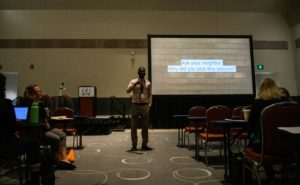This is the first year in a decade where my official title isn’t ‘teacher’, and it’s going ok so far. My new day-to-day life is quite a shift, so hopefully my entry for the #MTBoS Blogging initiative’s ‘Day-In-The-Life’ will still be relevant, even thought it is not as teacher-y as many other posts. Without further ado, here is my day as an administrator!
The day starts as I come up the stairs and see a couple of teachers chatting by the time clock to start the day. A year ago I would join in and chat about their life either in the class or outside of school. Instead, pupil personnel secretary flies in across the office and delivers me a confusing transcript request. A 40+ year old alumnus of our school wanted to have all of the school records sent to them. This was a standard request that didn’t really warrant an early morning cross-office sprint. Apparently this alumnus had recently transitioned genders and changed names (which is awesome) and they wanted to go back to college (also awesome) so they requested to not only receive all of the records, but also to have the name changed on the records to reflect this person’s new name which was sent to us on the court documents. The secretary wanted to know if we have to alter government documents, and face potential legal scrutiny, or if we have to send out the documents with no name changes and potentially spoil the chance of a fresh start for this former student’s new college enrollment. By the way, for people whose records are this old changes must be made on the physical documents, so it’s an either or choice. While I tried to not look utterly stumped at this secretary’s dilemma, the two teachers finished their conversation and headed up the stairs. For a second, I missed not being able to go up the stairs with them.
After I got to my desk and took my coat off, I immediately went into a flurry of meetings. First I planned and then facilitated the Attendance Committee meeting. We started talking about how difficult it is to bring students back in touch with their academics after being absent for 3-10 days straight. These kinds of absences are commonplace at a transfer school, and the failure to recover from them leads many students to giving up on school for this marking period, or in general.
When I finished the meeting, I threw out a series of Math Textbooks which were sent to us by one of the big publishing houses that the purchasing secretary left in my office. To legally throw these out we are supposed to cut off the front cover, but I was ripping both of covers off with my bare hands. Why did I decide to manhandle a bunch 500 page textbooks at 10 AM? Perhaps talking about attendance was a little frustrating.
Following this I began working with my Student Assistant on making a teacher profile page on the website. Our school has lots of internships around the city, but we also host internships in the building. This student was typing up interviews he had done with teachers while I gave him some advice (and in between I caught up on some emails).
At lunch I joined my Principal in preparing for the School Quality Review. The School Quality Review is the biggest thing that we as a school have to show our validity to the outside world. The reviewer comes to the school and works to understand all parts of the school. He meets with teachers, students, and parents, he observes classes, he reviews our artifacts. Then, a little after lunch, he locks himself in our office and determines the writing that will, for a lot of people, define our school for the next two years. I am sure the reviewer is a ‘he’ because we already know who the reviewer is. He also happens to be the director of the department of School Quality Reviews for the city. Needless to say, this is going to be a big deal. During lunch my principal and I explained all of this to small groups of staff in preparation.
Following the meeting I headed back to the desk with my assistant, but while he is working on the website I am preparing for my class. I am very lucky to be able to still teach a class as an administrator. This class is not a math class, and is an introductory computer science class, but I try my best to squeeze in some math along the way. I had one problem where the people had to program the game bizz buzz using Scratch. (I’m writing this well after the fact, so I think this might be what I did that day, I’m not sure…).
At the end of the class I headed back down to my office and prepared for the final meeting, which is the PD committee. This committee is a collaboration of the administration and our teaching staff to work together to design our staff’s professional development for the year. One of the new changes this year is that schools have to provide almost 3 times as much PD as they had the year prior. It was obvious that all schools would have trouble making use of the time, and we are no exception. These meetings have had a degree of friction this year, but it’s been positive friction. The kind of friction necessary before things get on the right track.
After that meeting, I frantically went back to my desk and tried to get random tasks finished. At the end of the meeting I only have about a half hour before heading to daycare to pick up Julianne, and I always end up going late. There is no worse feeling than showing up late to daycare and seeing my 6-month old with that “Why did all the other babies get to leave before me!!!” look on her face. Certainly I am going to have some of those days as we head towards the SQR, but luckily today wasn’t one of them.
So that’s my day in the life!


